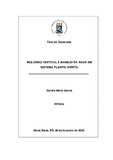| dc.creator | Garcia, Sandra Maria | |
| dc.date.accessioned | 2007-12-05 | |
| dc.date.available | 2007-12-05 | |
| dc.date.issued | 2005-02-28 | |
| dc.identifier.citation | GARCIA, Sandra Maria. VERTICAL MULCHING AND WATER MANAGEMENT IN NO TILLAGE SYSTEM. 2005. 193 f. Tese (Doutorado em Engenharia Agrícola) - Universidade Federal de Santa Maria, Santa Maria, 2005. | por |
| dc.identifier.uri | http://repositorio.ufsm.br/handle/1/3560 | |
| dc.description.abstract | With the main objective to evaluate the hydrological behavior of the vertical mulching in no tillage system, this work have been realized in 2002/2003 and 2003/2004 agricultural years on Latossolo Vermelho Distrófico típico in the plateaus of Rio Grande do Sul State. For this, two experiments have been
installed. The experiment one consisted of parcels without vertical mulching, with vertical mulching each 10 m and with mulching each 5 m, in the experimental delineation blocks by chance with three repetitions. Experiment 2 has been consisted of three parcels: the first without vertical mulching; the second with vertical mulching each 20 m and the third with vertical mulching each 10 m. All the furrows of vertical mulching had dimensions of 0,08 x 0,38 m and the length in accordance to the width of the parcel, filled with lightly compacted straw to provide stability to the walls of the furrow. In experiment 1 rain simulations have been made with two intensities (70 e 106 mm h-1) at two distinct periods, to determine the superficial runoff, the tax of basic infiltration
and the concentration of lost nutrients by the torrent. The presence of vertical mulching reduces the total losses of nutrients due to the reduction of the superficial runoff. In experiment 2 the hydrous balance has been carried
through. Infiltrations in furrows of different have been also determined. Vertical mulching postpones the beginning time of the superficial runoff in no tillage system and reduces the volume of superficial runoff significantly, increasing the tax of basic infiltration. In the periods that the hydrous balance has
been carried through, difference was not verified among the treatments in relation to the real evapotranspiration. How deeper the furrow depth is, higher the basic infiltration tax, since the horizontal basic infiltration tax has greater
importance in deepers furrows. | eng |
| dc.description.sponsorship | Conselho Nacional de Desenvolvimento Científico e Tecnológico | |
| dc.format | application/pdf | por |
| dc.language | por | por |
| dc.publisher | Universidade Federal de Santa Maria | por |
| dc.rights | Acesso Aberto | por |
| dc.subject | Agricultura | por |
| dc.subject | Pantio direto | por |
| dc.subject | Solo | por |
| dc.subject | Mulching vertical | por |
| dc.subject | Escoamento superficial | por |
| dc.subject | Balanço hídrico | por |
| dc.title | Mulching vertical e manejo da água em sistema plantio direto | por |
| dc.title.alternative | Vertical mulching and water management in no tillage system | eng |
| dc.type | Tese | por |
| dc.description.resumo | Com o objetivo principal de avaliar o comportamento hidrológico do mulching vertical em sistema plantio direto, realizou-se este trabalho nos anos agrícolas 2002/2003 e 2003/2004 em Latossolo Vermelho Distrófico típico no planalto
do Rio Grande do Sul. Para tanto foram instalados dois experimentos, dos quais o experimento 1 consistiu de parcelas sem mulching vertical, com mulching vertical a cada 10 m e com mulching vertical a cada 5 m, no delineamento
experimental blocos ao acaso com três repetições. O experimento 2 consistiu de três parcelas, sendo que uma sem mulching vertical, outra com mulching vertical a cada 20 m e a terceira com mulching vertical a cada 10 m. Todos os sulcos de mulching vertical tinham dimensões de 0,08 x 0,38 m e o
comprimento de acordo com a largura da parcela, preenchidos com palha levemente compactada para proporcionar estabilidade às paredes do sulco. No experimento 1 foram feitas simulações de chuva com duas intensidades
(70 e 106 mm h-1) em duas épocas distintas, para determinar o escoamento superficial, a taxa de infiltração básica e a concentração de nutrientes perdidos pela enxurrada. A presença de mulching vertical reduz as perdas totais
de nutrientes devido à redução do escoamento superficial. No experimento 2 foi realizado o balanço hídrico. Também foram determinadas as infiltrações em sulcos de diferentes. O mulching vertical protela o tempo para início do escoamento superficial em sistema plantio direto e reduz significativamente o volume de escoamento superficial, aumentando a taxa de infiltração básica. Nos períodos em que foi realizado o balanço hídrico, não foi verificada diferença entre os tratamentos no que se refere à evapotranspiração real. Quanto maior a profundidade do sulco, maior a taxa de infiltração básica, sendo que a taxa de infiltração básica horizontal tem maior importância em sulcos de maior profundidade. | por |
| dc.contributor.advisor1 | Righes, Afrânio Almir | |
| dc.contributor.advisor1Lattes | http://buscatextual.cnpq.br/buscatextual/visualizacv.do?id=K4787537Y9 | por |
| dc.contributor.referee1 | Reichert, José Miguel | |
| dc.contributor.referee1Lattes | http://buscatextual.cnpq.br/buscatextual/visualizacv.do?id=K4787840U9 | por |
| dc.contributor.referee2 | Lovato, Thome | |
| dc.contributor.referee2Lattes | http://buscatextual.cnpq.br/buscatextual/visualizacv.do?id=K4785553P9 | por |
| dc.creator.Lattes | http://buscatextual.cnpq.br/buscatextual/visualizacv.do?id=K4706059Y1 | por |
| dc.publisher.country | BR | por |
| dc.publisher.department | Engenharia Agrícola | por |
| dc.publisher.initials | UFSM | por |
| dc.publisher.program | Programa de Pós-Graduação em Engenharia Agrícola | por |
| dc.subject.cnpq | CNPQ::CIENCIAS AGRARIAS::ENGENHARIA AGRICOLA | por |


